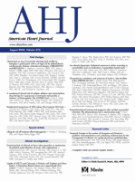Predictors of recurrent ischemic events and death in unstable coronary artery disease after treatment with combination antithrombotic therapy - 05/09/11
for the ESSENCE study group
Abstract |
Background Patients with non-Q-wave acute coronary syndromes (ACS) have substantial rates of recurrent ischemic events, but prognostic studies have been small or preceded the routine use of aggressive combination antithrombotic therapy. We sought to identify predictors of these events after antithrombotic treatment of non-Q-wave ACS. Methods We assessed 30-day rates of a composite triple end point (death, infarction, or refractory angina) and double end point (death or infarction) among 3171 patients with non-ST-segment elevation ACS randomly assigned to enoxaparin or heparin, plus aspirin, for 2 to 8 days. We created multivariable regression models to predict these end points from baseline factors. Results Overall, 682 patients (21%) reached the triple end point and 220 (6.8%) reached the double end point. Independent predictors of the triple end point were admission with myocardial necrosis, ST-segment depression, prior angina severity, symptom duration, and allocation to enoxaparin treatment in patients with ST-segment depression (significant interaction). Independent predictors of the double end point were admission with myocardial necrosis, ST-segment depression, enrollment region, age >75 years, prior angina severity, and rales. By deciles, the average predicted risk for the double end point ranged from 2% to 20%: a patient aged <75 years with no risk factors had a 3.5% risk, whereas a patient aged >75 years with 2 additional high-risk features (myonecrosis and ST depression) had a risk of death or reinfarction of 26%. Conclusions Patients with non-ST-segment elevation ACS exhibit a broad range of risk of adverse recurrent ischemic events. The predictive power of the model for the triple end point, using baseline variables, was modest. However, a subgroup at very low risk of the double end point (average 2%) can be identified with baseline variables. (Am Heart J 2000;139:962-70.)
Le texte complet de cet article est disponible en PDF.Plan
| ☆ | Supported by a grant from Rhône-Poulenc Rorer, Collegeville, Pennsylvania, and Paris, France. |
| ☆☆ | Guest Editor for this manuscript was Paul W. Armstrong, MD, University of Alberta, Edmonton, Alberta, Canada. |
| ★ | Reprint requests: Marc Cohen, MD, Division of Cardiology, Hahnemann University Hospital, mail stop 119, Philadelphia, PA 19102. E-mail: marc.cohen@tenethealth.com |
Vol 139 - N° 6
P. 962-970 - juin 2000 Retour au numéroBienvenue sur EM-consulte, la référence des professionnels de santé.
L’accès au texte intégral de cet article nécessite un abonnement.
Déjà abonné à cette revue ?

